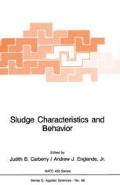Abstract
Sewage sludges possess several characteristics which directly inhibit the rate and performance (degree of clarification, thickening and dewatering) achieved by any solid-liquid separation process. The presence of colloidal particles increases the water binding, the specific resistance and the compressibility of the sludges; therefore, colloids adversely affect all processes of sedimentation and dewatering. Most sewage sludges exhibit a net negative charge. This charge makes the particles tend to repulse each other and thus resist agglomeration into larger particles. A large percentage of the sludge solids have a portion of bound water firmly attached to the particles. The retention of this water can result in a high water content respectively low in cake solids after solid-liquid separation. The objective of sludge conditioning is to alter any of the properties outlined above so as to increase the ease with which water can be removed from the sludge.
Access this chapter
Tax calculation will be finalised at checkout
Purchases are for personal use only
Preview
Unable to display preview. Download preview PDF.
References
A.L. Genter, Conditioning and Vacuum Filtration of Sludge, Sewage and Industrial Wastes 28, 829–840, 1956.
W. Vater and Z. Cieckiewicz, Beitrag zur Klarschlammzentrifugierung, Das Gas- und Wasserfach 115, 137–140, 1974.
H. Graefen and H.J. Donges, Studies on Parameters Affecting Sludge Dewatering in Pressure Filters in Advances in Water Pollution Research, Proceedings of the 5th International Conference held 1970 in San Francisco and Hawaii, Vol, I, Section II, Paper 30, p. 1–10, Pergamon Press, 1971.
Commission of the European Communities, European Cooperation and Coordination in the Field of Scientific and Technical Research, Eurocop-Cost, Cost-Project 68 Sewage Sludge Processing, Final Report of the Management Committee, November, 1975, Brussel/Belgium.
Author information
Authors and Affiliations
Editor information
Editors and Affiliations
Rights and permissions
Copyright information
© 1983 Martinus Nijhoff Publishers, The Hague
About this chapter
Cite this chapter
Möller, U.K. (1983). Reactions: Chemical Conditioning. In: Carberry, J.B., Englande, A.J. (eds) Sludge Characteristics and Behavior. NATO ASI Series, vol 66. Springer, Dordrecht. https://doi.org/10.1007/978-94-009-6860-8_8
Download citation
DOI: https://doi.org/10.1007/978-94-009-6860-8_8
Publisher Name: Springer, Dordrecht
Print ISBN: 978-94-009-6862-2
Online ISBN: 978-94-009-6860-8
eBook Packages: Springer Book Archive

